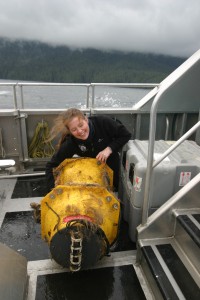Larry Pynn is publishing a special, six-part series on the State of the Salish Sea. We are happy for our work to be included.
His piece on 18 April addresses an issue that resonates with us: using hydrophones [underwater microphones] to measure ocean noise levels, while simultaneously collecting information on whale presence. We are a small organization, so we really like projects that accomplish two goals for the price of one. In BC, there has been a long tradition of using hydrophones to study killer whales. Our colleague, Dr John Ford at DFO, used hydrophones to discover that each killer whale family has its own unique dialect. That game-changing information launched countless follow-on projects, and has been instrumental in building a case that killer whales, like humans, possess culture.
Of course, many of our colleagues along the BC and Washington coast have been using hydrophones to monitor whale habitat usage for decades. You’re familiar with most of them (and apologies for missing anyone out). OrcaLab’s Orca-Live project is one of the most famous, but you should also check out BeamReach, CetaceaLab, Salmon Coast Field Station, Pacific Wild, Center for Whale Research, and the Vancouver Aquarium’s WildWhales program, all of whom use hydrophones to monitor whale usage along the coast.
So what’s new? Why is our “yet another hydrophone project” different from other studies?
The key difference is that we are using calibrated systems to measure noise levels. We are not just listening to whales; we are listening to the whales’ habitat. And because sound is as important to whales as vision is to us, whale habitat is acoustic habitat. Think of it as measuring the quality of whale habitat. We use “pop-ups” from Cornell University’s Bioacoustics Research Program to collect a systematic sample of underwater noise levels. And we are working with Chris Clark and his team at Cornell to quantify how these sounds might be perceived by fin, humpback and killer whales, and to predict how much of the whales’ calls may be “masked” by chronic ocean noise levels. The work is very much still in progress. We are trying to reduce more than 10,000 recordings to a simple take-home message, and that takes time. But we’re very excited to see the attention that is being paid now to ocean noise as a chronic habitat-level stressor in BC, and we’re anxious for our work to play a role in protecting key habitats for whales and other marine species that rely on a quiet ocean to survive.
Thanks for a great article, Larry. We look forward to seeing the rest of your series.

